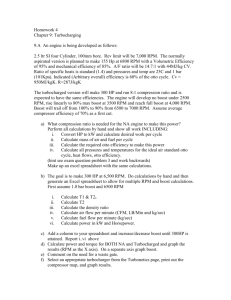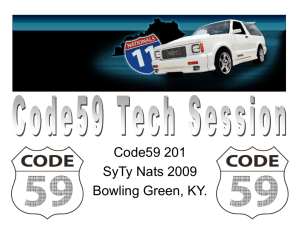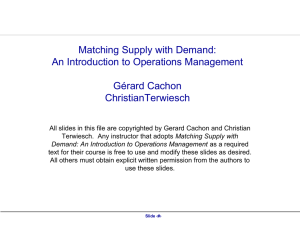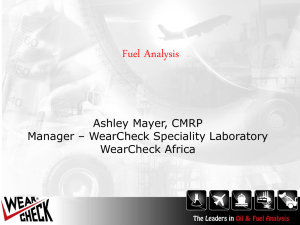Blenheim IV
advertisement
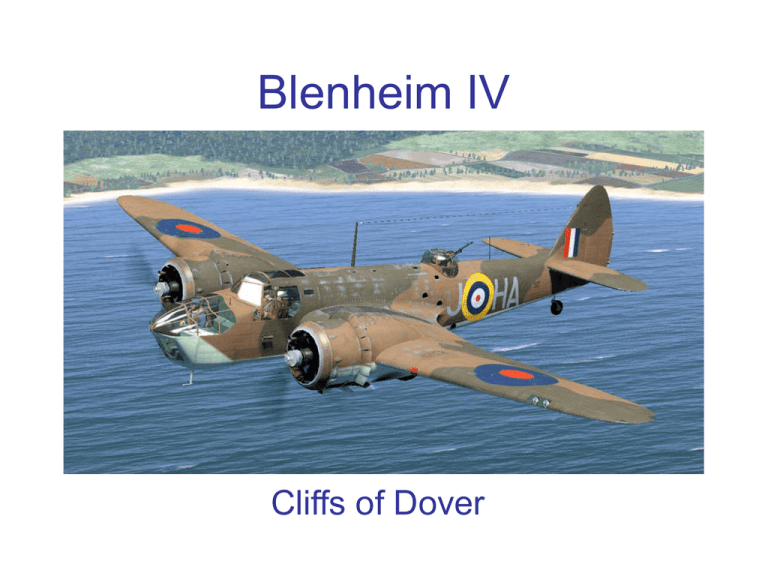
Blenheim IV Cliffs of Dover History The Blenheim during the Battle of Britain • The Blenheim units operated throughout the battle, often taking heavy casualties. • The Blenheim units raided German occupied airfields throughout July to December 1940, both during daylight hours and at night. Although most of these raids were unproductive there were some successes; – on 1 August five out of 12 Blenheims sent to attack Haamstede and Evere (Brussels) were able to bomb; destroying or heavily damaging three bf 109s of II./JG 27. Two other bf109s were claimed by Blenheim gunners. – Another successful raid on Haamstede was made by a single Blenheim on 7 August which destroyed one bf109 of 4./JG 54, heavily damaged another and caused lighter damage to four more. • There were also some missions which produced an almost 100% casualty rate amongst the Blenheims; one such operation was mounted on 13 August 1940 against a Luftwaffe airfield near Aalborg in north-eastern Denmark by 12 aircraft of 82 Squadron. One Blenheim returned early (the pilot was later charged and due to appear before a court martial but was killed on another operation), the other 11, which reached Denmark, were shot down, five by flak and six by bf 109s. • As well as the bombing operations, Blenheim-equipped units had been formed to carry out long-range strategic reconnaissance missions over Germany and German-occupied territories. In this role, the Blenheims once again proved to be too slow and vulnerable against Luftwaffe fighters and they took constant casualties. Introduction to crew positions Press C to move between positions Introduction to Crew Positions Bombardier Turret Gunner Alt-F to move to firing position Cockpit Controls Pilot view to lower left Throttle Quadrant Pilot view over right shoulder Pilot view to lower right Pilot view to upper left Pilot view to lower left Carburettor Heat Carburettor heat use: Set to on: a. For all flying at less than +3.5 boost, unless the ambient air temperature is above +15C. When it is higher than +15C, turn it off regardless of boost settings. (Magpie note: Suggest above 2,500ft. Dover average summer daylight temperature 20C, temp reduces by 13C per 6500ft, 1C per 500ft) . b. For all flying (irrespective of boost and atmospheric temperature) in conditions of high humidity, in or just below clouds, in rain, snow or sleet. It can also be used to help warming up the engines in very cold weather. Set to off for all other conditions including: a. Engine start at all times. b. Take off. c. Landing, except in the high humidity conditions. Technical Data Maximum takeoff power to 1000ft, 3 minutes limit: with 100 octane fuel (outer tanks): +9 boost 2750 RPM with 87 octane fuel (inner tanks only): +5 boost 2650 RPM Max. climb power, 30 minute limit: regardless of fuel octane rating +5 boost 2650 RPM cylinder head temps (CHT) at 210C oil temps at 80C Max. continuous power (no time limit) for rich mixture: regardless of fuel octane rating +3.5 boost, 2400 RPM CHT at 190C oil temps at 70CMax. continuous power (no time limit) for weak (lean) mixture: regardless of fuel octane rating +1.5 boost 2400 RPM CHT at 190C oil temps at 70C Max. all out limit (war emergency power): with 100 octane fuel: +9 boost, 2750 RPM CHT at 235C, oil temps at 90C 30 minutes time limit Indicated Airspeed (IAS) restrictions: Diving 325 mph Gear down 140 mph Flaps down 125 mph Diving Restrictions: maximum boost +5 maximum RPM 3120 exceeding 2750 RPM permitted only for 20 seconds with the throttle not less than 1/3rd of the way open Clearance for bomb drop with 500lb bombs (no idea about the 250lb ones): Dive 55 degrees Climb 40 degrees Bank 10 degrees Exceeding these during a bomb drop probably means that your bombs will bounce around inside your own aircraft. with 87 octane fuel: +5 boost, 2750 RPM 5 minutes time limit This is my first flight in a twin engine plane. What extra controls do I need to operate the Blenheim IV? • • • • • Select engine 1, 2 and all Open/Close Bomb Bay Doors Drop Bombs Carburettor Heat On/Off Suggest assign keys to awkward to click controls. Personal preference here, but I would suggest the following: – Radiator Open/Close – Propeller Pitch Increase/Decrease – Slow-running Cut-Out What controls need to be keyed? Start-up Procedure • Open starboard and port fuel cocks – One click, outer tank – Two-clicks, inner tank • • • • • • • • • • Open Radiator 100% Turn magnetos on (four) Check fuel mix is at normal (52%) Check fuel gauges Set propeller pitch to 100% Throttle to 10% Select engine one, prime engine, ignition (i) Select engine two, prime engine, ignition (i) Select both engines. During warm-up period set compass and directional gyro. Take-Off Procedure • • • • • • • • • • When engines have warmed to 100C, apply full left rudder, advance throttle carefully and taxi towards airstrip. Always be aware of engine temperature. Continue to apply full left rudder once commencing take-off roll. Rotation at 90mph Landing gear up immediately airborne. Reduce RPM via throttle or propeller pitch to prevent over-heating Fly level until airspeed builds up At 130mph adjust propeller trim to 0% Reduce radiator cowling as temperature cools, cruise between 190-210C. Trim rudder and elevators so a cruise of 220mph is attained.
